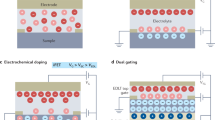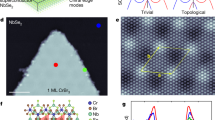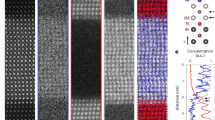Abstract
Liquid/solid interfaces are attracting growing interest not only for applications in catalytic activities and energy storage1,2, but also for their new electronic functions in electric double-layer transistors (EDLTs) exemplified by high-performance organic electronics3,4,5,6,7, field-induced electronic phase transitions8,9,10,11, as well as superconductivity in SrTiO3 (ref. 12). Broadening EDLTs to induce superconductivity within other materials is highly demanded for enriching the materials science of superconductors. However, it is severely hampered by inadequate choice of materials and processing techniques13. Here we introduce an easy method using ionic liquids as gate dielectrics, mechanical micro-cleavage techniques for surface preparation, and report the observation of field-induced superconductivity showing a transition temperature Tc=15.2 K on an atomically flat film of layered nitride compound, ZrNCl. The present result reveals that the EDLT is an extremely versatile tool to induce electronic phase transitions by electrostatic charge accumulation and provides new routes in the search for superconductors beyond those synthesized by traditional chemical methods.
This is a preview of subscription content, access via your institution
Access options
Subscribe to this journal
Receive 12 print issues and online access
$259.00 per year
only $21.58 per issue
Buy this article
- Purchase on Springer Link
- Instant access to full article PDF
Prices may be subject to local taxes which are calculated during checkout




Similar content being viewed by others
References
Simon, P. & Gogotsi, Y. Materials for electrochemical capacitors. Nature Mater. 7, 845–854 (2008).
Aricò, A. S., Bruce, P., Scrosati, B., Tarascon, J. M. & Schalkwijk, W. V. Nanostructured materials for advanced energy conversion and storage devices. Nature Mater. 4, 366–377 (2005).
Sandberg, H. G. O., Backlund, T. G., Osterbacka, R. & Stubb, H. High-performance all-polymer transistor using a hygroscopic insulator. Adv. Mater. 16, 1112–1115 (2004).
Shimotani, H., Diguet, G. & Iwasa, Y. Direct comparison of field-effect and electrochemical doping in regioregular poly(3-hexylthiophene). Appl. Phys. Lett. 86, 022104 (2005).
Panzer, M. J., Newman, C. R. & Frisbie, D. C. Low-voltage operation of a pentacene field-effect transistor with a polymer electrolyte gate dielectric. Appl. Phys. Lett. 86, 103503 (2005).
Takeya, J. et al. High-density electrostatic carrier doping in organic single-crystal transistors with polymer gel electrolyte. Appl. Phys. Lett. 88, 112102 (2006).
Shimotani, H., Asanuma, H. & Iwasa, Y. Electric double layer transistor of organic semiconductor crystals in a four-probe configuration. Jpn. J. Appl. Phys. 46, 3613–3617 (2007).
Dhoot, A. S. et al. Beyond the metal–insulator transition in polymer electrolyte gated polymer field-effect transistors. Proc. Natl Acad. Sci. USA 103, 11834–11837 (2006).
Misra, R., McCarthy, M. & Hebard, A. F. Electric field gating with ionic liquids. Appl. Phys. Lett. 90, 052905 (2007).
Shimotani, H. et al. Insulator-to-metal transition in ZnO by electric double layer gating. Appl. Phys. Lett. 91, 082106 (2007).
Dhoot, A. S., Israel, C., Moya, X., Mathur, N. D. & Friend, R. H. Large electric field effect in electrolyte-gated manganites. Phys. Rev. Lett. 102, 136402 (2009).
Ueno, K. et al. Electric-field-induced superconductivity in an insulator. Nature Mater. 7, 855–858 (2008).
Ahn, C. H. et al. Electrostatic modification of novel materials. Rev. Mod. Phys. 78, 1185–1212 (2006).
Kötz, R. & Carlen, M. Principles and applications of electrochemical capacitors. Electrochim. Acta 45, 2483–2498 (2000).
Schooley, J. F. et al. Dependence of the superconducting transition temperature on carrier concentration in semiconducting SrTiO3 . Phys. Rev. Lett. 14, 305–307 (1965).
Kawasaki, M. et al. Atomic control of the SrTiO3 crystal surface. Science 266, 1540–1542 (1994).
Ohnishi, T. et al. Determination of surface polarity of c-axis oriented ZnO films by coaxial impact-collision ion scattering spectroscopy. Appl. Phys. Lett. 72, 824–826 (1998).
Cho, J. H. et al. High-capacitance ion gel gate dielectrics with faster polarization response times for organic thin film transistors. Adv. Mater. 20, 686–690 (2008).
Yuan, H. T. et al. High-density carrier accumulation in ZnO field-effect transistors gated by electric double layers of ionic liquids. Adv. Funct. Mater. 19, 1046–1053 (2009).
Yamanaka, S., Kawaji, H., Hotehama, K. & Ohashi, M. A new layer-structured nitride superconductor. Lithium-intercalated beta-zirconium nitride chloride, LixZrNCl. Adv. Mater. 8, 771–774 (1996).
Takano, T., Kitora, A., Taguchi, Y. & Iwasa, Y. Modulation-doped-semiconductorlike behaviour manifested in magnetotransport measurements of LixZrNCl layered superconductors. Phys. Rev. B 77, 104518 (2008).
Novoselov, K. S. et al. Electric field effect in atomically thin carbon films. Science 306, 666–669 (2004).
Novoselov, K. S. et al. Two-dimensional atomic crystals. Proc. Natl Acad. Sci. USA 102, 10451–10453 (2005).
Ohashi, M., Nakano, H., Yamanaka, S. & Hattori, M. Hydrogen uptake by layer structured beta-ZrNCl. Solid State Ion. 32, 97–103 (1989).
Shamoto, S. et al. Hydrogen in beta-ZrNCl. J. Phys. Chem. Solids 60, 1511–1513 (1999).
Taguchi, Y., Kitora, A. & Iwasa, Y. Increase in Tc on reduction of doping in LixZrNCl superconductors. Phys. Rev. Lett. 97, 107001 (2006).
Miyazaki, H. et al. Inter-layer screening length to electric field in thin graphite film. Appl. Phys. Exp. 1, 034007 (2008).
Caviglia, A. D. et al. Electric field control of the LaAlO3/SrTiO3 interface ground state. Nature 456, 624–627 (2008).
Kosterlitz, J. M. & Thouless, J. D. Ordering, metastability and phase transitions in two-dimensional systems. J. Phys. C 6, 1181–1203 (1973).
Halperin, B. I. & Nelson, D. R. Resistive transition in superconducting films. J. Low Temp. Phys. 36, 599–616 (1979).
Susan, M. A. B. H., Kaneko, T., Noda, A. & Watanabe, M. Ion gels prepared by in situ radical polymerization of vinyl monomers in an ionic liquid and their characterization as polymer electrolytes. J. Am. Chem. Soc. 127, 4976–4983 (2005).
Tokuda, H., Tsuzuki, S., Susan, M. A. B. H., Hayamizu, K. & Watanabe, M. How ionic are room-temperature ionic liquids? An indicator of the physicochemical properties. J. Phys. Chem. B 110, 19593–19600 (2006).
Acknowledgements
We thank D. Chiba, Y. Ohno, F. Matsukura and H. Ohno for providing the electron beam lithography facility at the Laboratory for Nanoelectronics and Spintronics, Research Institute of Electrical Communication, Tohoku University. We also thank T. Takano, Y. Taguchi, K. Ueno, A. Tsukazaki, A. Ohtomo and M. Kawasaki for stimulating discussions. This research is financially supported by MEXT and JST.
Author information
Authors and Affiliations
Contributions
K.K. and Y.K. fabricated the pristine ZrNCl single crystals. H.T.Y. and H.S. tested the performance of ionic liquids. J.T.Y. and S.I. fabricated the EDLT devices. J.T.Y. carried out all of the measurements and analysed the data. J.T.Y. and Y.I. wrote the paper.
Corresponding authors
Supplementary information
Supplementary Information
Supplementary Information (PDF 1436 kb)
Rights and permissions
About this article
Cite this article
Ye, J., Inoue, S., Kobayashi, K. et al. Liquid-gated interface superconductivity on an atomically flat film. Nature Mater 9, 125–128 (2010). https://doi.org/10.1038/nmat2587
Received:
Accepted:
Published:
Issue Date:
DOI: https://doi.org/10.1038/nmat2587
This article is cited by
-
Green-light p-n junction particle inhomogeneous phase enhancement of MgB2 smart meta-superconductors
Journal of Materials Science: Materials in Electronics (2024)
-
Realizing metallicity in Sr2IrO4 thin films by high-pressure oxygen annealing
NPG Asia Materials (2023)
-
Coupled ferroelectricity and superconductivity in bilayer Td-MoTe2
Nature (2023)
-
Reversible metal-insulator transition in SrIrO3 ultrathin layers by field effect control of inversion symmetry breaking
Communications Materials (2023)
-
Wireless magneto-ionics: voltage control of magnetism by bipolar electrochemistry
Nature Communications (2023)



